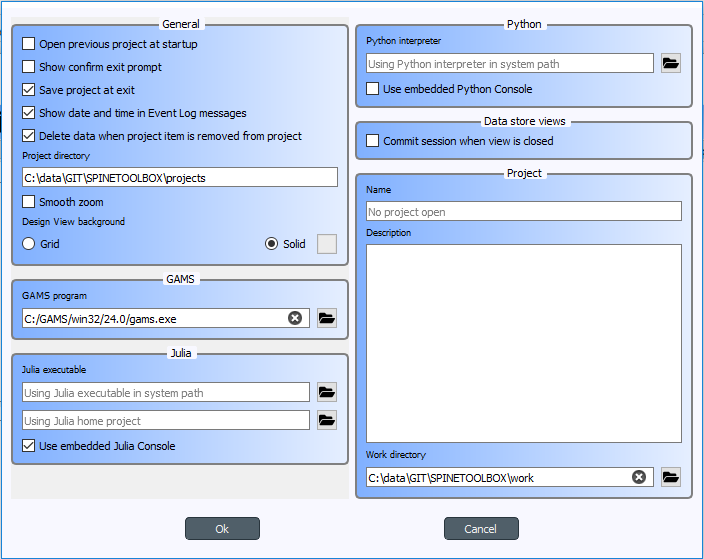Settings¶
Spine Toolbox settings are categorized in the following way
Application settings¶
You can open the application settings from the main window menu File->Settings…, or by pressing F1.

The settings on this form have been categorized into six categories. General, GAMS, Julia, Python and Data store views settings are general application settings, which affect all projects. Settings in the Project category only affect the current project.
General settings¶
- Open previous project at startup If checked, application opens the project at startup that was open the last time the application was shut down. If left unchecked, application starts without a project open.
- Show confirm exit prompt If checked, confirm exit prompt is shown. If unchecked, application exits without prompt.
- Save project at exit Unchecked: Does not save project and does not show message box. Partially checked: Shows message box (default). Checked: Saves project and does not show message box.
- Show date and time in Event Log messages If checked, date and time is appended into every Event Log message.
- Delete data when project item is removed from project Check this box to delete project item’s data when a project item is removed from project. This means, that the project item directory and its contents will be deleted from your hard drive.
- Project directory Directory where projects are saved. This is non-editable at the moment.
- Smooth zoom Controls the way zooming (by using the mouse wheel) behaves in Design View and Graph View. Controls if the zoom in/out is continuous or discrete. On older computers, smooth zoom is not recommended.
- Design View background Choosing grid shows a black grid as the Design View background. Choosing Solid and then clicking on the square next to it let’s you choose the background color.
GAMS settings¶
- GAMS program Path to Gams executable you wish to use to execute GAMS Tool templates. Leave this blank to use the system GAMS i.e. GAMS set up in your system PATH variable.
Julia settings¶
- Julia executable Path to Julia executable you wish to use to execute Julia Tool templates. This is the Julia that will be used in the embedded Julia Console and also the Julia that is used when executing Julia Tool templates as in the shell. Leave this blank, if you wish to use the system Julia.
- Julia home project Set the Julia home project here.
- Use embedded Julia Console Check this box to execute Julia Tool templates in the built-in Julia Console. If
you leave this un-checked, Julia Tool templates will be executed as in the shell. For example, on Windows this
would be the equivalent as running command
julia.exe example_script.jlin the command prompt. If you decide to use the embedded Julia Console, theexample_script.jlis included into the console and executed there. It is highly recommended to use the embedded Julia Console, since this gives significant performance improvements compared to shell execution.
Python settings¶
- Python interpreter Path to Python executable you wish to use to execute Python Tool templates. This is the Python that will be used in the embedded Python Console and also the Python that is used when executing Python Tool templates as in the shell. Leave this blank, if you wish to use the system Python.
- Use embedded Python Console Check this box to execute Python Tool templates in the embedded iPython Console.
If you un-check this box, Python Tool templates will be executed as in the shell. For example, on Windows this
would be the equivalent as running command
python.exe script.pyin the command prompt. If you decide to use the embedded Python Console, thescript.pyis executed there.
Data Store views settings¶
- Commit session when view is closed This checkbox controls what happens when you close the Tree view, the Graph view, or the tabular view and when you have uncommitted changes. Unchecked: Does not commit session and does not show message box. Partially checked: Shows message box (default). Checked: Commits session and does not show message box.
Project settings¶
These settings affect only the project that is currently open.
- Name Current project name. If you want to change the name of the project, use menu option File-Save as….
- Description Current project description. You can edit the description here.
- Work directory Directory where processing the Tool takes place. You can change this directory. Make sure to clean up the directory every now and then.
Project item settings / properties¶
Each project item (Data Store, Data Connection, Tool, View, and Data Interface) has its own set of properties. These are saved into the project save file. You can view and edit them in project item properties on the main window.
Application preferences¶
Spine Toolbox remembers the size, location, and placement of most of the application windows from the previous session (i.e. when closing and restarting the app).
Where are the Settings stored?¶
Application Settings and Preferences are saved to a location that depends on your operating system. On Windows,
there is no separate settings file, the settings are stored into registry key
HKEY_CURRENT_USER\Software\SpineProject\Spine Toolbox. It is safe to delete this key if you want to reset
application to factory settings.
Projects are saved to .proj files in the Project directory. In addition, each project has its own dedicated directory under the Project directory which can be used to keep data from different projects separate. All project items in a project have their own directory under that project’s directory, where individual project item data can be stored (e.g. .sqlite files in Data Store directories).